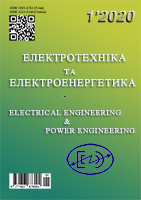Short-term forecasting of electricity consumption at the objects of the energy market with the use of the "GUSENITSA" -SSA method
DOI:
https://doi.org/10.15588/1607-6761-2020-1-4Keywords:
power consumption, an industrial facility of the energy market, "Caterpillar" -SSA ", forecasting, singular analysisAbstract
Purpose. The main goal of the study is to increase the efficiency of the operating mode of the power system by predicting the consumption of electric energy by consumers using the "Gusenitsa" -SSA method to reduce the error in predicting the electrical energy at the energy market facilities.
Methodology. The use of the method "Gusennitsa" -SSA for forecasting the consumption of electric energy of an industrial facility of the energy market is investigated.
Findings. This article explores the use of the Gusenitsa -SSA method for forecasting the electricity consumption of an industrial facility in an energy market. The basis of this study is to improve the efficiency of the power grid mode by forecasting electricity consumption by consumers, contractors and producers. Using modern methods of gathering statistical information allows you to make the right decisions in the planning and management of energy objects. The article presents the method of singular spectral analysis that allows the use of statistics of a non-stationary series. The use of the method of singular spectral analysis-SSA allows to obtain the forecasting error of electric energy on the objects of the energy market within the acceptable range. The obtained forecast electric consumption for some period will allow to control the electric power system by means of data collection devices. Data collection devices in automatic mode will transmit statistical information, and the software will adjust the predicted values of electricity ordered by the consumer, the supplier. This study allows us to use the method of singular spectral analysis in simple forecasting for the week, day, and hour before using statistical instruments. The results can be used in electricity for the preliminary forecasting of electricity consumption and the planning of electricity production and prices. The proposed method shows how to use the singular spectral in the prediction of electrical energy.
Originality. Research in the field of power consumption forecasting will reduce the forecasting error without using methods of analysis for the stationarity of power consumption time series
Practical value. It will allow you to order electric power from suppliers with a lower margin, this will increase the economy of consumers' funds.
References
[1] Makoklyuev, B.I., Vladimirov, A.I., (2001). Prediction of Power Consumption of Mosenergo JSC. Journal of Fuel and Energy Complex, No 4, Moscow.
[2] Solomkin, A.V., (2012). Short-term forecasting of electricity consumption using neural network methods. State University of NPP Mordovian State University Ogareva, Saransk.
[3] Golyadina, N.E., Danilova, D.L., Zhiglyavsky, A.A., (1997). Processing of multidimensional time series using the Caterpillar method. The main components of the time series are the Caterpillar method. ed.,: St. Petersburg, 105-131.
[4] Tsvetkov, E.I., (1973). Non-stationary random processes and their analysis. Moscow, Energy, 128 p.
[5] On Approval of the Methodology for Determining the Volume and Cost of Electricity Not Taken Due to Violation of Consumers' Rules of Electricity Utilization
[6] Chetyrkin, E.M., (1977). Statistical methods of forecasting. Moscow, Statistics, 263
[7] Bann, D.V., Farmer, E.D., (1987). Comparative models of electric load prediction. Moscow, Energoatomizdat, 200.
[8] Broomhead, D.S., King, G.P., (1086). Extracting qualitative dynamics from experimental data. No 20, 2-3, 217-236.
[9] Fraedrich, K. Atmos, J., (1986). Estimating the dimension of weather and climate attraction. No. 43, 419-432.
[10] Vautard, R., Ghil, M., (1989). Singular spectrum analysis in nonlinear dynamics, with applications to paleoclimatic time se-ries. No. 35, 3, 395-424.
[11] Ghil, M., Vautard, R., (1991). Interdecadal oscillations and the warming trend in global temperature time series. Nature, No. 350, 6316, 324-327.
[12] Schelkalin, V.N., (2012). Trend approach of time series prediction based on Goose-Nice method -SSA / VN. Schelkalin // Proceedings of the 14th SAIT 2012 International Scientific and Technical Conference, Kiev, April 24, 2012. / IPSA UNC NTUU "KPI". - K: IPSA UNC NTUU "KPI", 258 - 259.
[13] Shchekalin, V.N., (2012). A decomposition approach of time-series prediction based on the Track-SSA method / VN. Schelkalin // Proceedings of the 14th SAIT 2012 International Scientific and Technical Conference, Kiev, April 24, IPSA UNC NTUU "KPI". - K .: UNESCO "IPSA" NTUU "KPI", 260 - 261.
[14] Feast, N.E. (2003). The caterpillar method -SSA: time series forecast: uch. pos. St. Petersburg, 55 p.
[15] Solntsev, V.N., Danilov, D. L., Zhiglyavsky, A. A. (1997). The Main Components of the Time Series: The Caterpillar Method. St. Petersburg State University.
[16] Aleksandrov, F.I., (2003). Isolation of additive components of the time series based on the Gusenitsa method. St. Petersburg State University
Downloads
Published
How to Cite
Issue
Section
License
Copyright (c) 2020 V.P. ROZEN, Ya.M. DEMCHYK

This work is licensed under a Creative Commons Attribution 4.0 International License.
Creative Commons Licensing Notifications in the Copyright Notices
Authors who publish with this journal agree to the following terms:
Authors retain copyright and grant the journal right of first publication with the work simultaneously licensed under aCreative Commons Attribution License that allows others to share the work with an acknowledgement of the work's authorship and initial publication in this journal.
Authors are able to enter into separate, additional contractual arrangements for the non-exclusive distribution of the journal's published version of the work (e.g., post it to an institutional repository or publish it in a book), with an acknowledgement of its initial publication in this journal.
Authors are permitted and encouraged to post their work online (e.g., in institutional repositories or on their website) prior to and during the submission process, as it can lead to productive exchanges, as well as earlier and greater citation of published work.

